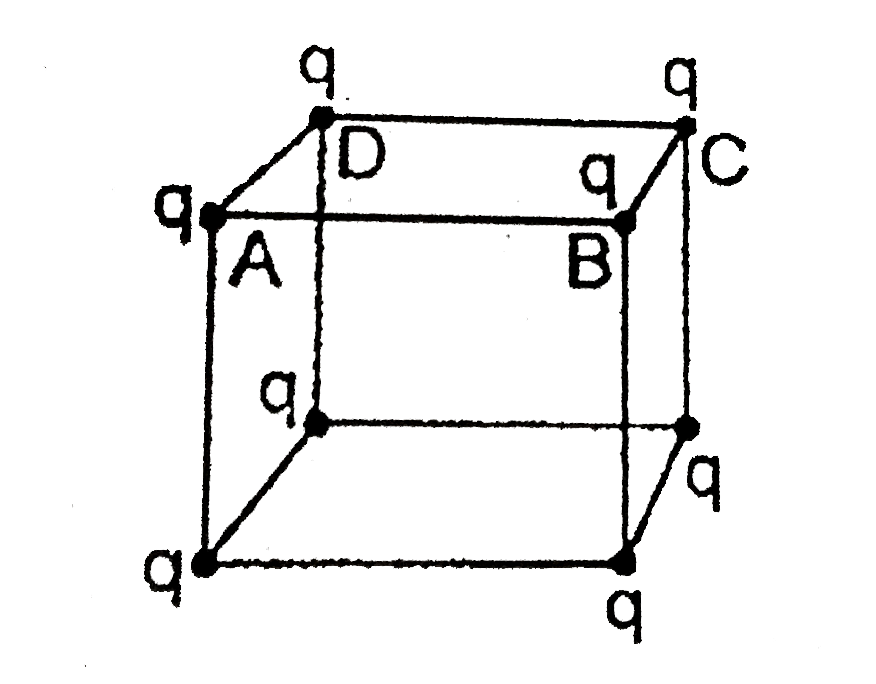A charge q is located at the centre of a cube. The electric flux through any face is
πq6(4πε0)
q6(4πε0)
2πq6(4πε0)
4πq6(4πε0)
The correct Answer is:D
To find the electric flux through any face of a cube with a charge q located at its center, we can follow these steps:
1. Understand Gauss's Law:
Gauss's Law states that the electric flux (Φ) through a closed surface is proportional to the charge enclosed (Q_enc) within that surface. Mathematically, it is expressed as:
\(
\Phi = \frac{Q_{\text{enc}}}{\epsilon_0}
\)
where \( \epsilon_0 \) is the permittivity of free space.
2. Identify the Charge and Surface:
In this case, we have a charge q located at the center of a cube. The cube has six faces.
3. Calculate Total Electric Flux through the Cube:
Since the charge q is at the center, the total electric flux through the entire cube is given by:
\(
\Phi_{\text{total}} = \frac{q}{\epsilon_0}
\)
4. Determine the Flux through One Face:
The cube has six identical faces, and by symmetry, the electric flux will be uniformly distributed across all six faces. Therefore, the electric flux through one face (Φ_face) can be calculated as:
\(
\Phi_{\text{face}} = \frac{\Phi_{\text{total}}}{6} = \frac{q}{6\epsilon_0}
\)
5. Final Expression:
Thus, the electric flux through any face of the cube is:
\(
\Phi_{\text{face}} = \frac{q}{6\epsilon_0}
\)
Final Answer:
The electric flux through any face of the cube is \( \frac{q}{6\epsilon_0} \).
Gauss's Law states that the electric flux (Φ) through a closed surface is proportional to the charge enclosed (Q_enc) within that surface. Mathematically, it is expressed as:
\(
\Phi = \frac{Q_{\text{enc}}}{\epsilon_0}
\)
where \( \epsilon_0 \) is the permittivity of free space.
In this case, we have a charge q located at the center of a cube. The cube has six faces.
Since the charge q is at the center, the total electric flux through the entire cube is given by:
\(
\Phi_{\text{total}} = \frac{q}{\epsilon_0}
\)
The cube has six identical faces, and by symmetry, the electric flux will be uniformly distributed across all six faces. Therefore, the electric flux through one face (Φ_face) can be calculated as:
\(
\Phi_{\text{face}} = \frac{\Phi_{\text{total}}}{6} = \frac{q}{6\epsilon_0}
\)
Thus, the electric flux through any face of the cube is:
\(
\Phi_{\text{face}} = \frac{q}{6\epsilon_0}
\)
The electric flux through any face of the cube is \( \frac{q}{6\epsilon_0} \).
Similar Questions
A charge Q is situated at the centre of a cube. The electric flux through one of the faces of the cube is
View SolutionA charge q is placed at the centre of a cube. What is the electric flux passing through the cube?
View SolutionA charge Q is situated at the corner of a cube, the electric flux passing through all the six faces of the cube is :
View SolutionCharge of 2 C is placed at the centre of a cube. What is the electric flux passing through one face ?
View SolutionA very small sphere having a charge q, uniformly distributed throughout its volume, is placed at the vertex of a cube of side a. The electric flux through the cube is
View SolutionA charge Q is placed at the centre of a cube. Find the flux of the electric field through the six surfaced of the cube.
View SolutionEight point charges (can be assumed as small spheres uniformly charged and their centres at the corner of the cube) having values q each are fixed at vertices of a cube. The electric flux through square surface ABCD of the cube is

View SolutionEight point charges (can be assumed as small spheres uniformly charged and their centres at the corner of the cube) having values q each are fixed at vertices of a cube. The electric flux through square surface ABCD of the cube is

View SolutionA charge q is placed at the centre of a cube of side l what is the electric flux passing through two opposite faces of the cube ?
View SolutionA charge q is placed at the centre of a cube of side l what is the electric flux passing through two opposite faces of the cube ?
View Solution
